Ways of Promoting Creativity in the Classroom
Vicky Saumell, Argentina
Vicky Saumell holds a Diploma in the Theory and Methodology of TESOL. She has written and tutors New Learning Environments for the Master’s in ELT at Universidad de La Sabana, Colombia and teaches at Instituto San Francisco de Asis in Buenos Aires. She is also a freelance author and has written for Pearson and Cambridge University Press. E-mail: vicky.s@umell.com.ar, Website: www.vickysaumell.com
Menu
Introduction
Background
Practical ideas
Conclusion
References
As Einstein once said, “Creativity is intelligence having fun”. And as such I think creativity should be an important aspect of teaching and learning. However, it depends on us that creativity finds a place in our classrooms.
Some perceived barriers to creativity are routine, close-ended tasks, fear of being wrong or making mistakes, tight rules and the perception that fun is not conducive to learning. So varying what we do in the classroom, going for open-ended tasks, creating a safe environment for risk taking, having flexible rules according to aims and allowing for experimentation are some ways of creating an atmosphere where creativity can arise more easily.
Although my teaching background is mostly with teenagers, the ideas in this article can be used with all age groups. In my teaching practice, I have experimented with different ways of bringing my students’ creativity to life and it is their pieces of work which you will see in this article. I have found different ways of stimulating creativity and these are some practical ideas that have worked for me.
Allow for open ended tasks so that students have room for choice.
Choice is a natural partner of creativity. If you limit your students’ work by providing stiff guidelines, it will be harder for creativity to arise. Open ended tasks in general and providing choices within tasks can deeply influence creativity from the very beginning.
An example of this is the following set of tasks for students to choose after we read an abridged version of ´A Midsummer Night´s Dream´ by William Shakespeare in three versions: play, prose and comic strip.
|
A Midsummer Night’s Dream:
Choose what you want to work on from this list
One from this list
- Act out a scene: Choose a scene (or portion) to present to the class. You may choose to rewrite your scenes or present them as they are.
- Create a puppet show of a scene
- Analyze Shakespeare´s language use in the original play
- Compare the three versions: prose, cartoon, play
- 60 second Shakespeare: create a 60-second video, slideshow, animation, rap or poem about the play
- Analyze Shakespeare´s time at the time of this play
- Character Diaries: Choose a character and write a journal/diary from his/her point of view retelling all the events he/she experienced.
- A set of comprehension activities (worksheets)
- Create a stage setting and costume design for the play
Or two from this list
- Create a diagram of flow chart of the four pairs of lovers – Theseus/Hippolyta, Oberon/Titania, Lysander/Hermia, and Demetrius/Helena – and explain how it changes throughout the play to the final pairings.
- Which of the four women is more like a modern-day woman? In what ways is each of them modern?
- Character analysis: choose one character and analyze it
- Write Agony Aunt letters from: Hermia, Helena and Egeus.
- Write or perform an interview with a character
- Conflict resolution: Hermia’s father wants her to marry Demetrius. But she loves Lysander, and Lysander loves her. According to ancient laws without her father’s approval, she can’t marry him!!
- What would happen nowadays in the same situation?
- Why do young people in love sometimes experience conflict with their parents?
- What is the best way to resolve a conflict?
If you have another idea, tell the teacher to see if it´s possible
|
One example of a chosen task from this list is the comparison of the three versions we read using a Venn diagram.
[image1] Comparison of 3 different versions of ‘A Midsummer Night’s Dream’ done by Rocio P.
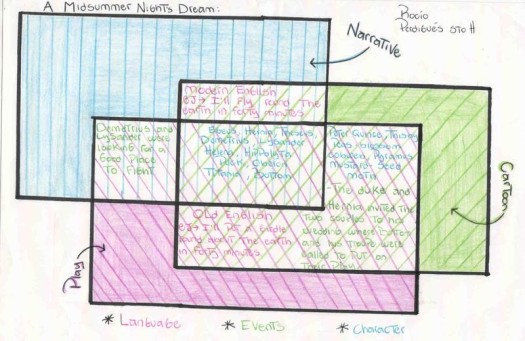
Allow them to be exposed to different uses of language.
Course books are generally filled with narrative and informative texts. Explore different genres and creative expressions. What about shape poems, haikus, classics with alternative endings, literal videos? You can then ask your students to try writing their own. Here are some suggestions:
- Word Whirls and other shape poems collected by John Foster is a delightful collection of shape poems that can show students an alternative way of writing poetry.
- Hairy Tales and Nursery Crimes by Michael Rosen is a collection of well-known tales with alternative endings.
- Wicked World by Benjamin Zephaniah is a collection of poems on very interesting topics. You can also find videos of Benjamin Zephaniah himself reciting the poems.
- The Melancholy Death of Oyster Boy and other stories by Tim Burton is a fantastic collection of poems aligned with the film director’s wacky style. There are also videos extending the stories in his poems.
- Literal Harry Potter and the Deathly Hallows Trailer is an example of alternative narrative in modern times. You can find it at www.youtube.com/watch?v=aVZNif6sd2s
Allow them to express who they are in different ways.
Find new ways of doing the getting-to-know-you kind of activities. Let them talk about or show their interests and talents. For example, you can use Wordle to have your students create a word art poster about themselves and then use it in a variety of ways.
[image 2] A Wordle poster created by Agustina G.
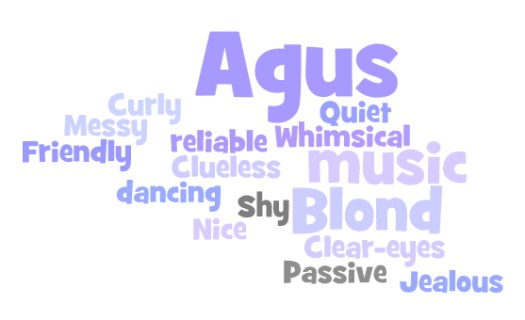
Another option is using Glogster for students to create interactive posters about themselves.
Another idea is using an existing advertising campaign as a trigger for the students to create their own version of it, especially if it lends itself to the exploration of the self and the possibility of expressing who they are. In this case, students tried to emulate the ads in an HP campaign with the slogan ´The computer is personal again´. You can watch an example production created by Barbara B. here [link www.youtube.com/watch?v=yJQi5XUp2U0&feature=youtu.be]
Allow them to become somebody else.
Provide alternatives through creative writing, drama, digital storytelling. For example, you can ask them to research a time and place of their choice and then write a diary entry about a typical day in their life pretending they are somebody from that period. You will be amazed at who they choose to be: a samurai, a Native American, a Jew in Nazi Germany, a hippie, a Beatle-maniac, a 9-11 witness, even Leonardo Da Vinci!
[image3] Leonardo Da Vinci’s day by Ignacio G.
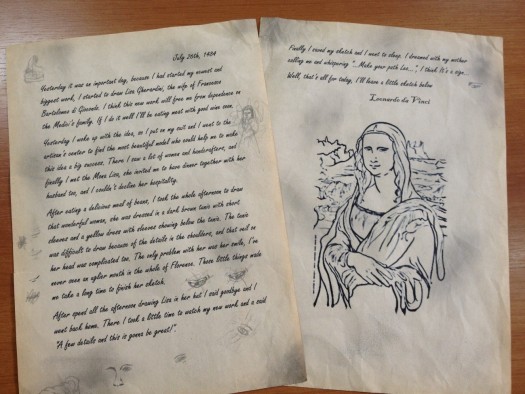
An extract of the text in the photograph
… July 26th 1484
Yesterday it was an important day, because I had started my newest and biggest work, I started to draw to Lisa Gherardini, the wife of Francesco Bartolomeo di Giocondo. I think this new work will free me from dependence on the Medici’s family. If I do it well I’ll be eating meat with a good wine soon.
Yesterday, I woke up with the idea, so I put on my suit and I went to the artisan’s center to find the most beautiful model who could help me to make this idea a big success. In there I saw a lot of women and handcrafters, and finally I met the Mona Lisa, she invited me to have dinner together with her husband too, and I couldn’t decline her hospitality.
After ate a delicious meal of beans, I took the whole afternoon to draw that wonderful woman, she were dressed with a dark brown tunic with short sleeves and a yellow dress “that had sleeves sticking out below the tunic”. The tunic was difficult to draw because of the details in the shoulders, and that veil on her head was complicated too. The only matter on her, was her smile, I’ve never seen an uglier mouth in the hole Florence…
Allow them to explore literature in different ways.
Let them choose how to respond to a reading. Promote new ways of doing book reports. For example, when we read an abridged version of A Midsummer Night’s Dream, I suggested a list of possible options including making a video, writing character diaries, comparing different versions, doing character analysis, creating the stage setting and costume design, acting out a scene, among others. Here are some of my students´ productions http://isfa.wikispaces.com/A+Midsummer+Night%C2%B4s+Dream
Another example are these responses to the reading of ´The Enormous Crocodile´ by Roald Dahl.
[image 4] A newspaper article reporting the news mentioned in the story written by Oriana L.
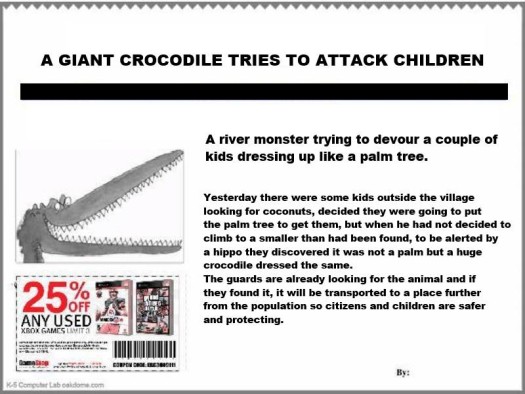
[image5] A different ending as imagined and written by Nicolas P. and Santiago M. G.
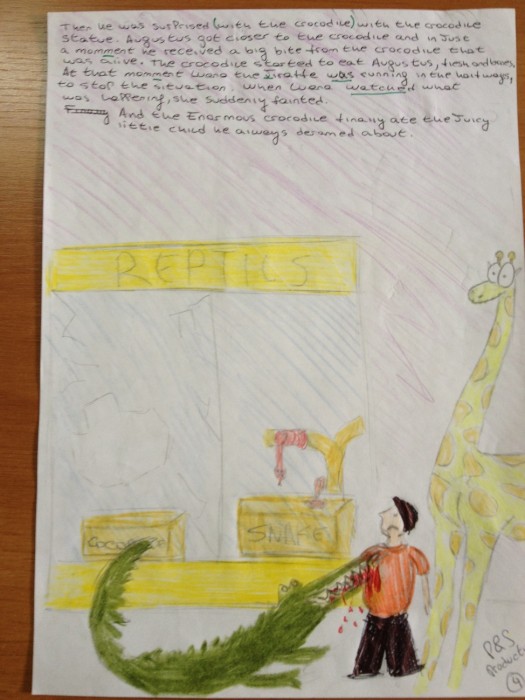
Promoting creativity in the classroom calls for an open-minded teacher. Think of different ways of doing the things you usually do. Be open to suggestions from your own students and guide them as to how they can achieve what they want to do. You will discover your students are a rich source of creative power that they can unleash under your mindful guidance.
| This article is based on a presentation given at IATEFL Harrogate 2014 and is also published in IATEFL 2014 Harrogate Conference Selections (2015) |
Burton, T. (1997) The Melancholy Death of Oyster Boy & Other Stories. New York: Harper Entertainment.
Foster, J. (comp.) (1998) Word Whirls and Other Shape Poems. Oxford: Oxford University Press.
Saumell, V. (2015) Ways of promoting creativity in the classroom in Pattinson, T. (Ed.). 2015. IATEFL 2014 Harrogate Conference Selections. Kent: IATEFL.
Zephaniah, B. 2000. Wicked World! London: Puffin.

Please check the Creative Methodology for the Classroom course at Pilgrims website.
Please check the Methodology & Language for Secondary Teachers course at Pilgrims website.
Please check the English Language Improvement for Teachers course at Pilgrims website.
Please check the English Language Improvement for Adults course at Pilgrims website.
Please check the Teaching Advanced Students course at Pilgrims website.


|